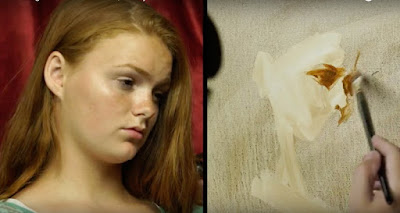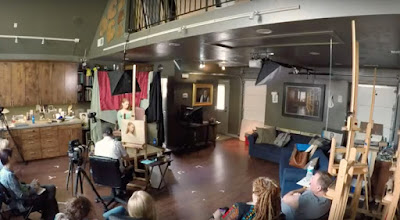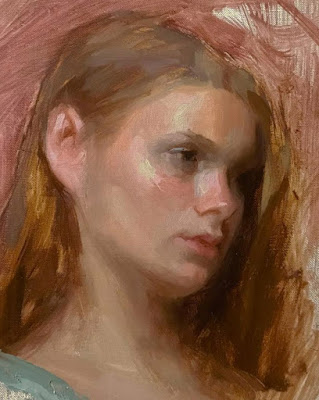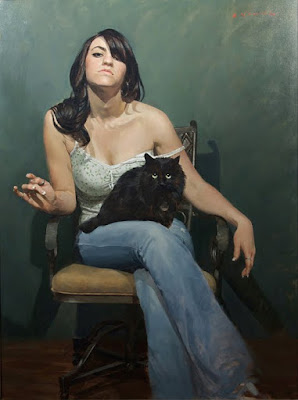Title : Casey Childs Interview
link : Casey Childs Interview
Casey Childs Interview
Utah-based portrait painter Casey Childs has released his first video tutorial called "Painting the Direct Portrait."
The video is a little over three hours long, and it covers the process of painting a head study of a young female model.
The audio consists of the artist describing what he's doing and what he's thinking to a small studio audience, who occasionally ask questions.
He starts right out talking about materials, color choices, and how he lays out his palette. His first step is to tone the canvas with a light grayish brown color, and then block in the simple impression of the light and shadow pattern. He then builds the form by modulating the values and detailing the individual features.
At a few points throughout the process, he clarifies his points with special graphics, such as as the high contrast image at left.
For most of the video, you see a split screen, with the model on the left and the developing painting on the right. Whenever he pauses to mix a color, the edit cuts to a down-facing camera showing what's happening on the palette.
After watching the video, I asked him a few questions:
Childs: The model is the daughter of our good friend and neighbor. I chose her for her fair skin and red hair and thought it would be a great combination for a portrait. When setting up the pose, I'm simply looking for an interesting design—how the abstraction of light and dark shapes together make a compelling image. Part of the reason of this particular pose was that I knew I wouldn't be able to work as fast while explaining my process, so I made it easier on myself to not have to paint the other eye! Ha!
Would you have used a similar approach with a different model under different circumstances?
The approach would be the same for any other circumstance because this is how I'm always thinking about painting, although color choices and finish may differ depending on the finish and mood I'm trying to create.

Many other portrait painting teachers (such as Nathan Fowkes, Scott Waddell, and Jeff Watts) emphasize the importance of doing a careful structural line drawing before embarking in paint. In your approach, you start right out mapping tonal shapes and considering the edges between them, without defining the form or the structure.

Many other portrait painting teachers (such as Nathan Fowkes, Scott Waddell, and Jeff Watts) emphasize the importance of doing a careful structural line drawing before embarking in paint. In your approach, you start right out mapping tonal shapes and considering the edges between them, without defining the form or the structure.
We all know that correct drawing is the most important aspect of any work, so I love how the structural method focuses on that first and foremost to make sure the drawing is sound before anything else is considered. But I feel like my art heroes—Sargent, Sorolla, Zorn, to name a few— considered all aspects (drawing, value, color, edges) that make up a great painting at once.
What do you have to say about the structural foundation method? Why do you recommend your method? What are the advantages and limitations of it?
I'm constantly thinking about structure and form while painting, but trying to be more efficient in the application. I believe this method helps maintain an energetic freshness as well as being easier to create atmosphere. The danger is, that if not careful, the drawing can lose structure and forms can become too generic.
 |
| Casey Childs self portrait |
If I'm not freaking out at least once during the process, the painting probably isn't any good. I think you need to take some risks to keep the application fresh and interesting. I've gained confidence in my process to the point where I have a pretty good idea what my painting will ultimately become with enough time. But I think doubts come when you stop trusting the process.
How does filming and narrating your approach affect your confidence? What do you tell students who are blocked by fears or doubts? Is overconfidence a hazard?
There was definitely moments during this demonstration where I wasn't sure if I could bring it together into something resembling a human, but I got there by trusting the process.

Since this is your first major tutorial video download, what made you decide to shoot and edit the video in this way? What advice would you give to other artists who want to produce a tutorial download?
Well, you can't teach what you don't know, and I really feel like I've gained an understanding of foundational skills and a knowledge of seeing in this way (mass vs. line) to be able to explain it. I also feel like watching someone paint can be quite boring, so I knew I didn't want to produce a long video. I've put together a video that I think is informative with many key concepts demonstrated in three short hours that explain the basis of my approach. I felt it important to see the model in split screen to really show how I'm simplifying the complexity of the information I see on the model.


Since this is your first major tutorial video download, what made you decide to shoot and edit the video in this way? What advice would you give to other artists who want to produce a tutorial download?
Well, you can't teach what you don't know, and I really feel like I've gained an understanding of foundational skills and a knowledge of seeing in this way (mass vs. line) to be able to explain it. I also feel like watching someone paint can be quite boring, so I knew I didn't want to produce a long video. I've put together a video that I think is informative with many key concepts demonstrated in three short hours that explain the basis of my approach. I felt it important to see the model in split screen to really show how I'm simplifying the complexity of the information I see on the model.

What are you trying to accomplish with your portraits? Are you trying to capture a specific likeness of your individual model, or are you going for more of a type or a character? Do you make any conscious changes or enhancements to express your personal impression of the model, or do you try to paint exactly what you see?
The basis of my approach to painting is capturing what I see. And I feel that is very beneficial in portraiture. It's not like I'm always going after a likeness, but it usually appears as a result of a careful search of the relationship of simple shapes and forms that are the characteristic and impression of the individual I'm painting. The question I'm often asked is how do I get a likeness, there's no secret or formula, it's just more accurate seeing and drawing.

The basis of my approach to painting is capturing what I see. And I feel that is very beneficial in portraiture. It's not like I'm always going after a likeness, but it usually appears as a result of a careful search of the relationship of simple shapes and forms that are the characteristic and impression of the individual I'm painting. The question I'm often asked is how do I get a likeness, there's no secret or formula, it's just more accurate seeing and drawing.

For your studio compositions or portraits, do you use photographs for reference?
Yes, I use photos. I think photos can be a great resource and tool for the artist, many of the great artists use(d) them.
How do you feel about using photos?
With a solid knowledge of drawing and form, an artist can use photos with great results. Photos are not as useful when the artist is not using them as a reference and merely copying.
Do you ever project or trace them?
I don't have a problem with projecting or tracing. It's way to speed up the process, but its damaging if used to skip the training of learning how to see.
How does your thought process change when you use them?
We all know that photos can't replicate the values and color range our eye can see, so when using them I have to be aware of those differences. And along with that, I try not to copy exactly what I see in the photograph but instead use them as a reference to what I've observed from life.
-----
"Painting the Direct Portrait" is 192 minutes long. The digital download is $34.95. A combined package with DVD + digital is $69.99.
Thus Article Casey Childs Interview
That's an article Casey Childs Interview This time, hopefully can give benefits to all of you. well, see you in posting other articles.
You are now reading the article Casey Childs Interview with the link address https://idealbodys.blogspot.com/2018/11/casey-childs-interview.html



0 Response to "Casey Childs Interview"
Post a Comment